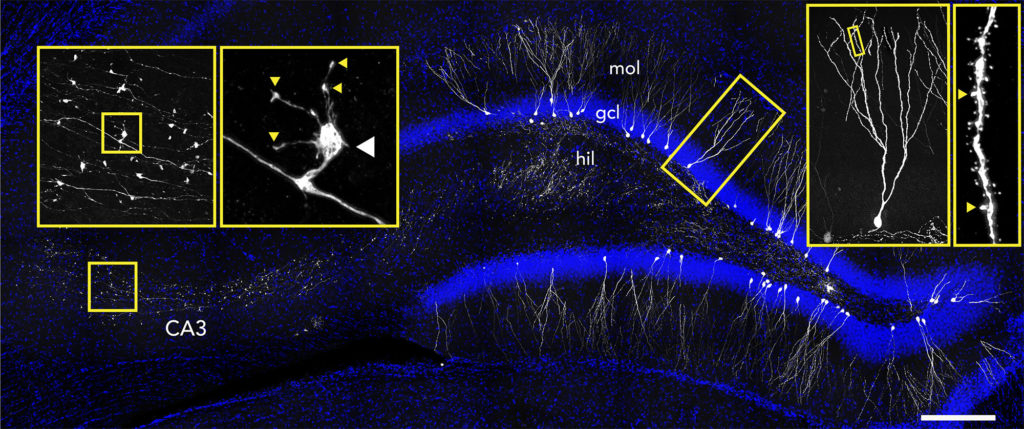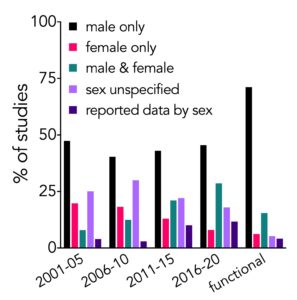
Happy to announce a new publication that has been many years1 in the works, “Sex differences in the spatial behavior functions of adult-born neurons in rats“, led by former postdoc Tim O’Leary.
In this study, we inhibited adult neurogenesis in female and male transgenic rats to see what happens to learning ability. We know that hippocampal neurogenesis contributes to learning, and that it also regulates the stress response, but no one has really looked at whether these 2 functions interact. New neurons often aren’t needed to learn in standard spatial learning paradigms like the water maze but we predicted that they might become more important under conditions of stress. So, here we therefore used a cold water maze to induce higher levels of stress. Specifically, we predicted that stress might impair learning when you don’t have neurogenesis, since we had previously found that neurogenesis buffers the effects of stress.
Somewhat consistent with our prediction, our first results indeed found that blocking neurogenesis altered learning under stressful conditions, but we were shocked that the rats actually learned faster without new neurons! I remember thinking, “We must be doing something wrong…but what?”. Well, just like (most) everyone else at the time, when this project began we were mainly using male animals for our projects. And so there ended up being a surplus of female rats that were available for this study. Maybe what we did “wrong” was to use females? And so we decided we really should repeat the experiment in males, since our hypothesis was completely built on data from male subjects (that was all that was available in the literature). And when we did we found what we originally expected, that blocking neurogenesis impaired learning under stress. At first, these results were completely paradoxical. But as is often the case, once you look into the literature you begin to see parallel stories and you actually start to believe your data! In this case, it was prior work, showing that stress can have opposite effects on learning in males and females2, that gave me some reassurance in the early stages of this project.
So there you have it: neurogenesis is good for males and bad for females!?! “Faster is better” is the usual interpretation when it comes to maze data, but somehow here it seems less plausible, no? Indeed, once we looked in detail, we found that the more important result might be how stress altered behavioral strategies in males and females. In males, neurogenesis caused rats to adopt similar escape strategies regardless of stress; in females neurogenesis caused rats to shift their strategies depending on stress. This is interesting because it suggests that neurogenesis could be playing equally important but complementary roles in the two sexes. It’s likely that, in a different type of learning situation, blocking neurogenesis would cause males to learn faster and females to learn slower.
We also looked at activity-dependent (immediate-early) gene expression and found big differences between the sexes (suggestive of different strategies and approaches to learning) but no differences related to neurogenesis. Interestingly, new neurons in males were significantly more plastic in males that in females, in response to learning. The consequence of this plasticity is still a bit of a mystery but it fits with previous evidence that males tend to show more (or different) stress-related plasticity in CA3, which is part of the same circuitry as the newborn neurons.
What else? Well, in writing up this manuscript we were aware that there was a huge disparity in how males and females have been included in neurogenesis research. We therefore decided to quantify it (and publish it on Figshare, here):
Clearly, most studies have only examined male subjects. And while things may be improving (more studies are including females), a significant proportion still do not specify the sex of their subjects or actually report/analyze the male vs female data, as has recently been reported for neuroscience more broadly. There are certainly a lot of interesting and important discoveries to be made!
Head over to eNeuro if you want the data in all its juicy details…
1Aside from the fact that the lab moved during this project (right after the behavioral experiment were completed), including both sexes was one of the reasons this study took so long to complete (about 8 years). A study with behavioral, retrovirus-morphology and neural activity components is one thing but then double it? And have large enough sample sizes that you are really confident in the results?
2for example work by Shors and Bangasser, Luine, Conrad
3In fact, we have included the underlying data as extended material, partly as a result of interactions with reviewers, who prompted us to more comprehensively report our statistics and effect sizes.
